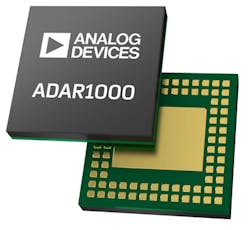Beamformer IC Shrinks Size of X/Ku-Band Antennas (.PDF Download)
Electronically steerable antennas are gaining favor in radar, communications, and satellite communications (satcom) applications due to several key benefits. The capability to re-position an antenna quickly, the availability of low-profile designs, and longer operating lifetimes continue to make active electronically steered antennas (AESAs) attractive choices compared to mechanically steered dish antennas.
All of these applications require a transmit and receive function with gain and phase controls that can significantly increase the size of the antenna with many radiating elements. However, that’s not the case with the ADAR1000 active antenna integrated circuit (IC) developed by Analog Devices. This four-channel X/Ku-band antenna beamforming chip provides 31-dB gain from 8 to 16 GHz with full 360-deg. phase control. It also includes dedicated memory and power detectors for ease of use. All that in a 88-pin LGA package measuring just 7 × 7 mm.
TDD and FDD
The ADAR1000 (Fig. 1) isn’t simply an active antenna chip—it’s a programmable antenna array in a miniature chip-sized package that enables four channels of efficient transmission and reception across its wide frequency range. It supports time-division-duplex (TDD) operation, replacing as many as 12 discrete components for antenna phase and gain adjustments from 8 to 16 GHz.
1. The ADAR1000 active antenna beamforming chip provides the operation of the receiving and transmitting of the cycle from 8 to 16 GHz.
The chip also can be configured to work in a frequency-division-duplex (FDD) system, such as a satcom application, by running the transmit (Tx) function only in one IC and the receive (Rx) function only in a second IC, powering off the unused portion of the circuit. The densely packed active circuit is fabricated in a commercial SiGe BiCMOS semiconductor process with high repeatability.
The ADAR1000 may simplify the design of communications systems antennas, but it does not sacrifice performance. It maintains gain flatness of typically ±1 dB for any 1-GHz bandwidth between 9 and 14 GHz, with gain flatness of typically ±2 dB from 9 to 14 GHz and typically ±3 dB from 8 to 15 GHz. The gain variations with temperature are typically ±3.5 dB for operating temperatures from −40 to +85ºC.
Four power detectors in the IC have 30-dB detection ranges; an 8-b analog-to-digital converter (ADC) can be used with the power detectors and temperature sensor. It even includes bias and control circuitry for use with external Tx/Rx modules to further simplify the design process.

